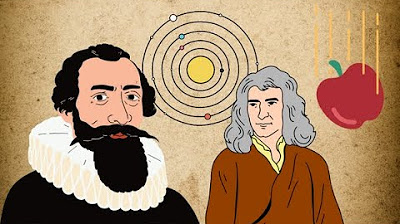Three women who changed how we see the universe | BBC Ideas
Summary
TLDRThis video highlights three pioneering women in astronomy who transformed our understanding of the universe. Henrietta Swan Leavitt discovered a key law about star distances, enabling Edwin Hubble to identify galaxies. Cecilia Payne-Gaposchkin revealed that stars are made of hydrogen and helium, despite resistance from male colleagues. Vera Rubin uncovered the existence of dark matter, a mystery that still puzzles scientists. Despite facing obstacles like gender bias and balancing family life, these women made groundbreaking contributions that continue to inspire astronomers today.
Takeaways
- 🌟 Jo Dunkley highlights three influential women astronomers who made groundbreaking contributions in the 19th and 20th centuries despite challenges.
- 🔭 Henrietta Swan Leavitt joined the Harvard College Observatory in 1895 and was part of a group of women known as the Harvard Computers, classifying stars.
- ✨ Leavitt discovered a pattern in stars' brightness, now known as Leavitt's Law, which helped determine distances of stars by measuring their pulsing rates.
- 🌌 Edwin Hubble used Leavitt's discovery to prove that smudges of light in the sky were distant galaxies, showing the universe was much larger than previously thought.
- 📚 Cecilia Payne-Gaposchkin, another Harvard astronomer, proposed that stars are primarily made of hydrogen and helium using quantum physics insights in the 1920s.
- 🚫 Payne-Gaposchkin faced opposition from the established astronomer Henry Norris Russell, who discouraged her from publishing her bold theory, but she was later proven right.
- 🏅 Payne-Gaposchkin became the first female head of astronomy at Harvard, breaking barriers in the field.
- 👩🔬 Vera Rubin, an American astronomer in the 1950s, discovered that galaxies were spinning too fast, revealing the presence of invisible dark matter.
- 🚻 Rubin was the first woman allowed to use the Palomar Observatory, overcoming institutional barriers like a lack of women’s facilities.
- 🌠 The discoveries of Leavitt, Payne-Gaposchkin, and Rubin continue to inspire modern astronomers, especially women, proving their lasting influence in the field.
Q & A
Who was Henrietta Swan Leavitt and what was her significant contribution to astronomy?
-Henrietta Swan Leavitt was an astronomer who worked at the Harvard College Observatory in 1895. Her most significant contribution was the discovery of 'Leavitt's Law,' which established a relationship between the brightness and pulsation rate of stars, enabling astronomers to calculate the distance to stars and galaxies.
What challenges did Leavitt and her fellow 'Harvard Computers' face in their work?
-Leavitt and her female colleagues, known as the 'Harvard Computers,' were not allowed to operate telescopes and were paid very little. Despite these obstacles, they made crucial contributions to the field of astronomy.
How did Leavitt's discovery influence Edwin Hubble's work?
-Leavitt's discovery of the relationship between star pulsation and brightness helped Edwin Hubble in the 1920s to determine that certain 'smudges' of light in the sky were actually entire galaxies, vastly expanding the known size of the universe.
What did Cecilia Payne-Gaposchkin discover about stars?
-Cecilia Payne-Gaposchkin discovered that stars are primarily composed of hydrogen and helium, a groundbreaking idea that contradicted the prevailing belief that stars had similar compositions to Earth.
Why was Payne-Gaposchkin advised to remove her discovery from her PhD thesis?
-The well-known astronomer Henry Norris Russell advised Payne-Gaposchkin to remove her idea about the composition of stars from her PhD thesis because it contradicted the established scientific consensus at the time. However, her theory was later proven correct.
What major achievement did Payne-Gaposchkin accomplish later in her career?
-Cecilia Payne-Gaposchkin became the first female head of astronomy at Harvard University, breaking significant gender barriers in the field of astronomy.
What was Vera Rubin's groundbreaking discovery about galaxies?
-Vera Rubin discovered that galaxies were spinning much faster than expected, leading to the conclusion that they are surrounded by a large amount of invisible dark matter, which holds them together.
What obstacles did Vera Rubin face while conducting her research?
-Vera Rubin faced challenges such as balancing her scientific career with raising children. Additionally, she was the first woman allowed to use the Palomar Observatory, where she had to create her own makeshift women's bathroom by pasting a paper skirt on the men's bathroom door.
Why is Vera Rubin's discovery of dark matter so important?
-Rubin's discovery of dark matter is crucial because it revealed that most of the universe’s mass is invisible and not yet understood. Dark matter remains one of the biggest mysteries in modern astrophysics.
How do the stories of these women continue to inspire today?
-The perseverance, intelligence, and groundbreaking work of Henrietta Leavitt, Cecilia Payne-Gaposchkin, and Vera Rubin continue to inspire new generations of scientists, highlighting the importance of diverse perspectives in scientific discovery.
Outlines

هذا القسم متوفر فقط للمشتركين. يرجى الترقية للوصول إلى هذه الميزة.
قم بالترقية الآنMindmap

هذا القسم متوفر فقط للمشتركين. يرجى الترقية للوصول إلى هذه الميزة.
قم بالترقية الآنKeywords

هذا القسم متوفر فقط للمشتركين. يرجى الترقية للوصول إلى هذه الميزة.
قم بالترقية الآنHighlights

هذا القسم متوفر فقط للمشتركين. يرجى الترقية للوصول إلى هذه الميزة.
قم بالترقية الآنTranscripts

هذا القسم متوفر فقط للمشتركين. يرجى الترقية للوصول إلى هذه الميزة.
قم بالترقية الآنتصفح المزيد من مقاطع الفيديو ذات الصلة

Nicolaus Copernicus: Challenging the Church with the Heliocentric Theory | BIOGRAPHY

ExoDet1A: Kepler's Laws | 1. Celestial Mechanics | EXOPLANET DETECTION

Breaking barriers with quantum physics | Dr. Shohini Ghose | TEDxNickelCity

Universo Mecánico 06 La Ley de Newton

Science Questions: What is Kepler's Third Law?

Teaching astronomy and space: Models of the Solar System; Earth, Sun and Moon
5.0 / 5 (0 votes)
